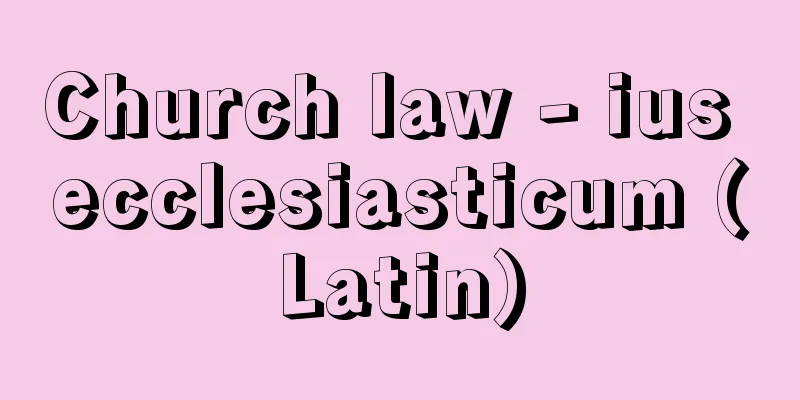Church law - ius ecclesiasticum (Latin)

|
This refers to the legal system that governs the faith and life of Christian groups, as well as their organization, management, and administrative activities. In the past, it was also widely called "canon law" (ius canonicum). The word canon has the same origin as the "teaching" used by the Apostle Paul (Galatians 6:6). As can be seen from the series of "teachings" collected by the apostles in the New Testament, from the early days of the Christian church, church councils were held to reconcile different opinions on fundamental issues of faith, the rules of life that believers should observe, and general religious practices, and in the name of the councils, resolutions were made by the church legislative bodies of the time, and decrees were issued by the church authorities, such as the Pope and bishops, which constituted church law. As the Antiochene Decrees were cited at the Council of Chalcedon (451) shows, a collection of canon laws already existed in the 5th century, but the systematization of canon law took a major breakthrough in the 12th century. According to the classification by source of law, the most important of the church laws is the "divine law" (ius divinum) by the word of God, and based on this divine law as a premise and starting point, the "personal law" (ius humanum) was established by the legislative body of the church. This is the church law in the narrow sense, which is further divided into written law and unwritten law. [Junro Ishida] Denominations and Church LawCanon law has been emphasized and followed mainly by the Roman Catholic Church, the Church of England, and the Eastern Orthodox Church. The most important of these is the "Roman Catholic Canon Law." In fact, the Catholic Church refers to the Codex Iuris Canonici (promulgated in 1917 and put into effect the following year), which contains 2,414 laws, as canon law. It covers a wide range of subjects, covering five sections: general provisions, persons, property, proceedings, crimes, and punishments. Its function has been distinguished from private law, criminal law, procedural law, etc., which belong to national law in later generations, and as "canon law" officially approved by authorities such as the Pope and ecumenical councils, it has been recognized as an expression of the fundamental characteristics of the church. However, church law is not considered an end in itself, but a necessary means to the church's goals, as can be seen from the close and inseparable bond between law and the church's doctrine and moral theology. In the Roman Catholic Church, the establishment and enforcement of church law is carried out within the church, independent of general secular power, and the church has established its own legislative, administrative, and judicial organizations, which differs from the concept of church law in general Protestant churches. [Junro Ishida] Church and State LawThe relationship between church law and general state law has been debated among Protestant churches for many years. While recognizing the uniqueness of church law, the majority of church churches ultimately believe that it cannot deviate from general legal concepts and therefore prefer to maintain a tension between the two. However, even those who view canon law as something distinct from state law do not agree that the church should remain without legal order, but rather that the church's legal order is rooted in God's will and that the Bible is, so to speak, the fundamental law. Therefore, even "confessional documents" contain legal principles, and the church's "constitutional rules" can be considered to be a codification of canon law in accordance with the general legal system. In any case, what is commonly expressed is that canon law does not, except in rare cases, have corporal or capital punishment, nor imprisonment or fines, but instead is characterized by "methods of persuasion." Moreover, it is this method of persuasion that is more appropriate and effective than state laws that include penalties. In addition to being considered a law unique to the Christian world, church law has also become the basis of modern legal thinking and has had a major influence on national and international law around the world, as can be seen in many examples such as the abolition of slavery, the improvement of the legal status of women, the strengthening of the marriage system, the humanitarianization of the penal system, and the establishment of methods for peaceful resolution of international conflicts. [Junro Ishida] Source: Shogakukan Encyclopedia Nipponica About Encyclopedia Nipponica Information | Legend |
|
キリスト教信徒集団の信仰および生活の規範や、その機構、運営、活動行政にかかわる法体系をさす。古くは、広く「カノン法」ius canonicumともよばれてきた。カノンは、使徒パウロが用いた「おしえ」(「ガラテヤ書」6章6)と語源をともにする。『新約聖書』のなかに、すでに使徒たちによって集収された一連の「おしえ」をみることができるように、キリスト教会では、初期より、信仰の根本問題や信徒の守るべき生活規律について、また一般宗教的慣習について、異なる意見の調整を図り、その問題解決のために教会会議が開かれ、会議の名において、つまり当時の教会立法機関によって決議がなされたり、教会の権威者、すなわち教皇や司教から教令が出されたりして、これらが教会法を構成していった。カルケドン公会議(451)において「アンティオキア法令」が引照された事実が示すように、5世紀にはすでに「教会法令集」が存在していたが、12世紀に至って教会法の体系化は画期的に行われた。 法源による分類によれば、教会法でもっとも重要なものは神のことばによる「神法(しんぽう)」ius divinumで、この神法を前提とし出発点にして、「人定法(じんていほう)」ius humanumが教会の立法機関によって制定された。これが狭義の教会法で、さらに成文法と不文法に分けられる。 [石田順朗] 教派と教会法教会法は、主として、ローマ・カトリック教会とイギリス国教会(イングランド教会)や東方正教会によって重視され、遵法されてきた。なかでも重要なのは「ローマ・カトリック教会法」である。事実、カトリック教会では、2414の法令を含む『ローマ教会法典』Codex Iuris Canonici(1917年公布、翌年施行)をさして教会法とよんでいる。それは、総則、人、物、訴訟、犯罪、刑罰の5編に及ぶ広範囲にわたるものであり、その機能は、後世、国家法に属する私法、刑法、訴訟法などとは区別されていて、教皇や公会議などの権威によって公認された「カノン法」として、教会の基本的特質の表明であると認められてきた。 しかし、教会法は、それ自体を目的にするものではなく、教会のよって目標とすることのために必要な手段と考えられていて、それは、法と教会の教義および道徳神学とが密接不可分に結合していることでもわかる。ローマ・カトリック教会では、教会法の制定とその執行を、一般世俗の権力から独立して、教会内部で行い、教会の独自な立法・行政・司法組織を確立していて、その点では、一般プロテスタント教会における教会法概念と相違する。 [石田順朗] 教会法と国家法教会法と一般国家法との関連性については、プロテスタントの諸教会間で、長年、論議されてきているが、そこでは、教会法の独自性を認めながらも、究極的には、一般の法観念から逸脱することはできないとして、いわば、緊張関係を保つというのが大勢の意向である。 ただ、国家法から区別されたものとして教会法をとらえる立場でも、教会が法的秩序を欠いたままでよいというのではなくして、教会の法的秩序はあくまで神の意志に根ざすものであり、聖書がいわば根本法であると理解する限りでは、広く同調点がみられる。したがって、「信仰告白的文書」にしても法的原則を含み、教会の「憲法規則」も、教会法を一般法体系にのっとって成文化したものと考えられる。ともあれ、共通に表明されるところは、教会法では、体刑や極刑はもとより、自由刑や罰金刑が、希少例を除いて、ないかわりに、「説得の方法」を特徴としている。しかも、この説得方策こそ、刑罰を伴う国家法にまさって、適切有効であるとし、教会法が、キリスト教界独自の法として考えられるほかに、近代法思考の基盤となり、世界諸国の国家法や国際法へも大きな影響を及ぼしていることは、奴隷制度の廃止、婦女の法的地位の向上、婚姻制度の強化、刑罰制度の人道化、国際紛争の平和的解決方法の樹立などと、数多い事例にみられるところである。 [石田順朗] 出典 小学館 日本大百科全書(ニッポニカ)日本大百科全書(ニッポニカ)について 情報 | 凡例 |
<<: Kirchengut (German: Church territory)
Recommend
Republic of Kalmykia (English spelling)
A republic in the western part of the Russian Fede...
Barnaul (English spelling) Барнаул/Barnaul
It is the administrative center of the Altai regi...
Crevass
… glissade: the technique of sliding down a slope...
The Owa sect theory
A doctrinal debate took place between the Hosso a...
Giolitti - Giovanni Giolitti
Italian politician. He entered politics in 1882 a...
Lloyds Bank plc
A major British commercial bank with its headquart...
Gutter
A device that collects rainwater from the roof an...
Saibara
Popular songs from the Heian period. These were o...
Basic map - Kihonzu (English)
A map of the largest scale, which is a systematica...
Kashan (English spelling)
A city in the southeastern part of Markazi Provinc...
Ookido Kuroushi - Ookido Kuroushi
…However, he soon stopped performing at theaters ...
Locustana pardalina (English spelling)
...Lachoppers that fly in swarms are called flyin...
Muricidae - Muricidae
...In Japan, purple dye was extracted from the pl...
Fish scales illustrated book
A land register from the Ming and Qing dynasties ...
Uterus - Shikyu (English spelling)
It is a female internal reproductive organ locate...









